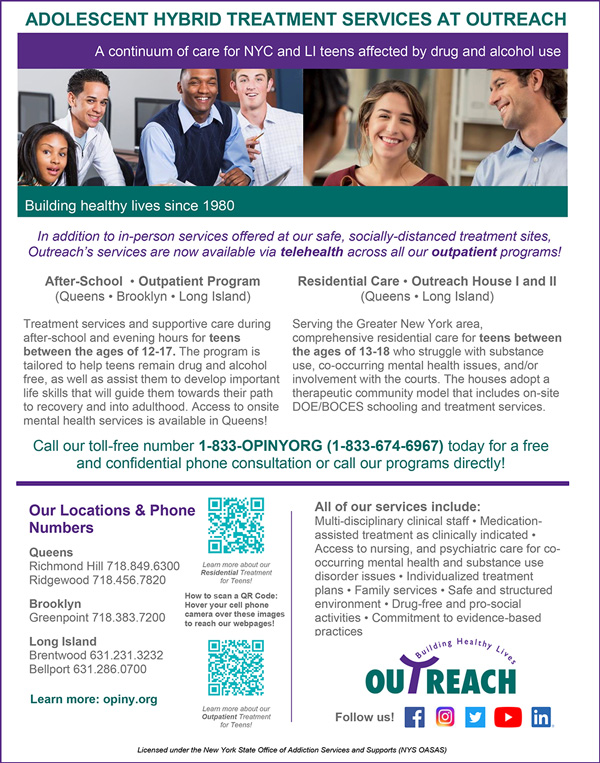I was once told early in my career that the Therapeutic Community (TC) takes an hour to explain but a lifetime to master. The traditional Therapeutic Community model has saved countless lives over the past several decades featuring a therapeutic milieu that uses the community as the healer and peers as role models as its cornerstone pieces (G. De Leon, 2000).

Originally designed for adults, the success of the model paved the way for adaptations to fit the needs of special populations such as adolescents which is perhaps the most challenging stage of development in the life cycle. Many developmental tasks must be accomplished for the young person to make a healthy shift from being a child, to a young adult who has individuated and separated from their parents. Given the complexities of this life stage, when a young person experiences consequences from substance use and mental health disorders, the treatment must be specialized to meet their needs.
Outreach opened their first adolescent treatment facility in 1984 with a program design based off of the traditional Therapeutic Community. Over the past 38 years, the agency has dedicated resources to evolving a highly specialized model of care that integrates both Therapeutic Community constructs with adolescent development.
Realizing most teenagers possess little intrinsic motivation to stop their substance use and the accompanying lifestyle, the addition of parents into the program design is paramount. Essentially, if we don’t have the parents on board, we will be hard pressed to get the adolescent to engage. By having parents in a parallel treatment process through a comprehensive array of family services, treatment outcomes for teenagers improve. Working with the parents, we shift the entire family system to increase the likelihood that gains achieved by the teen in treatment will be sustained after they return home after treatment.
Peer relationships during adolescence become extremely important as a source of support and reassurance. Unfortunately, these powerful bonds can become destructive when substance use and other risk behaviors enter the picture. Normative social development becomes delayed and even arrested as substance use progresses and mental health worsens. The adolescent therapeutic community features peers as role models who are substance free, in recovery and nurturing pro-social relationships. The program design strategically allows new members to enter an environment where pro-social behavior garners acceptance and feeds the adolescent’s desire to fit in and belong. The young person now has the opportunity to assimilate into a community of their peers who value their recovery and positive behavior.
The integrated model must provide age appropriate services to meet the adolescent’s developmental needs in each life domain. The evolution of the TC over time allowed for the integration of highly specialized mental health services so adolescents with co-occurring mental health disorders may be treated under one roof (NIDA, Principles of Effective Treatment, 3rd Edition, 2018). Additionally, services include a full day of school on-site, individual and group therapies addressing both SUD and Mental Health, family, vocational/educational, and physical health.
While I could go into great detail about the clinical services, I choose to highlight a core belief that serves as the common denominator to all these services. We must remember the population being served, teenagers! They are young, full of life and have a strong desire to be with their friends and have fun. While treatment involves a great deal of work, making treatment and recovery fun is a key variable in a successful program for adolescents. Making services fun is not mutually exclusive with being clinically effective. The creativity and energy of the adolescents will provide great insights and ideas for making treatment for teenagers life-changing while being fun. Adolescents always love when they can have input into programming, formats, and events occurring in the treatment milieu as it appeals to their emerging autonomy.
While traditional talk-therapy still has its place in the TC, adolescents will surely shut down if the service delivery is not creatively diversified. To improve engagement and retention with teens, there must be an integration of a variety of multi-modal therapies. Drumming circles, music therapy, creative art therapy, yoga, and meditation to name a few. These formats are both fun and healing which is exactly what we want as we put teenagers on the journey of recovery. After decades of work at Outreach, the clinical team recognizes adolescents seem to learn best by hands-on approaches than the traditional didactic deliveries. The more that an adolescent equates recovery with being something they can have fun in, the greater the chance they stay engaged in recovery support activities after the residential treatment episode has ended.
It is so important to remember adolescent culture is pop culture. It changes all the time. This is both the challenge and exciting part of working with adolescents as we must continue to evolve the therapeutic milieu to be effective with the kids of today. Adolescents are very perceptive and if they believe the adults working the TC are not current in their understanding of the adolescent world, it will be hard to achieve credibility and trust with the young person.
My final thought is this, if you are creating an adolescent TC, ensure that the staff are of course talented clinicians, and also that they are strong educators. Another attribute not often mentioned is staff should be “good actors”. Teens will be more receptive to adults that adjust their delivery styles just as an actor assumes different acting roles. To each individual teenager, the staff must assume a delivery that allows the adolescent to be willing to listen to what the staff has to offer. Remember, adolescents are in the process of separating and individuating from their parents. The last thing they will entertain is another adult that feels more like another parent. They will however enjoy a strong therapeutic alliance with an adult that is relatable and sees them as a unique individual through a person-centered lens.
John Venza, LCSWR, LMHC, is VP, Residential and Adolescent Services, at Outreach. For more information, contact John Venza at johnmvenza@opiny.org.






